
48 Employee Engagement Statistics You Need to Know for 2025
Organizations face significant challenges as employees demand more from employers. As social beings, we need to feel valued and recognized for our work.
Successful companies often prioritize their people. With high employee engagement comes a competitive advantage, increased profits, productivity, innovation, and bottom-line growth.
Everyone knows this, but what are companies actually doing about it? How much of your budget goes towards training, retaining, and staying in touch with former employees?
As the market-leading alumni engagement platform, EnterpriseAlumni has uncovered the latest employee engagement statistics you need to know about this year.
Let's dive in.
Key Statistics
- According to Gallup, only 21% of employees are engaged globally, with the U.S. being the highest (33%) and Europe (14%) lowest. [21]
- Businesses with engaged employees report 23% higher profits than businesses with disheartened workers. [22]
- Recognized employees are 44% more likely to be "thriving" overall. [21]
- More than 80% of executives rate employee engagement as important or important for their company. [14]
- According to FlexJobs, the number of reasons why people leave their job was toxic company culture (62%), followed by poor management (56%) and healthy work-life balance (49%) [18]
- Employees that aren't recognized are 8x as likely to be actively disengaged and 4x times as likely to look for a new job. [23]
- Employees that are disengaged cost the world $7.8 trillion in productivity. That's equal to 11% of the world's GDP. [21]
- People who haven't been recognized at work are 2x as likely to look for a new job in the next 12 months. [22]
- Employees who strongly believe that recognition is crucial in their workplace are 91% more likely to thrive. [23]
What is employee engagement?
Employee engagement refers to the level of involvement an employee has towards their work and the organization they work for. It measures how dedicated and motivated an employee is in their role, and how invested they are in the company's overall success.
There are three main types of employee engagement:
- Affective engagement - refers to an employee's emotional attachment to their job and the organization. It's about how positively they feel about their work and how much they care about their employer's goals.
- Behavioral engagement - this type of engagement is about an employee's actions and behaviors, such as their level of commitment, involvement, and dedication to their work.
- Cognitive engagement - this refers to an employee's mental investment in their work and the organization. It's about how much they understand and believe in their role, the company's values and mission, and how their work contributes to its success.
All three types of engagement are important and can impact an employee's job satisfaction, performance, and overall engagement level.
Why is employee engagement important?
Employee engagement is one of the most crucial factors in determining work satisfaction. It's not just the nature and trend of work that's changing: employees' needs are shifting too. They want to stay in an organization where they feel valued and have a sense of belonging.
Here are some of the benefits of employee engagement for your business:
- Organizations with high levels of employee engagement saw a 20.1% growth in revenue over 3 years, which is 2.3 times higher than the average growth rate of 8.9%.
- Low engagement and unmanaged stress can lead to burnout. This can cause low motivation and an inability to complete tasks. However, recognizing an employee's work can reduce the risk of burnout by 73%.
- When employees feel engaged, they put in more effort, and the company reaps the rewards. An engaged workforce is at least 17% more productive, contributing to higher profitability and employee turnover.
- Engaged employees are more committed to their organization and are 56% less likely to seek new opportunities.
- Employees with a strong sense of belonging to their company and team are more apt to work together harmoniously and foster a collaborative atmosphere, leading to increased involvement and a virtuous circle.
Factors that Affect Employee Engagement
The three most crucial factors affecting employee engagement are:
- Organization
- Managers
- Process
Let’s explore each one.
The Organization
Organizational culture impacts employee behavior and interaction. To assess the organization, it's crucial to examine if there's a culture of engagement that includes policies promoting employee motivation, respect and empowerment. Additionally, the organization must ensure that employees understand the goals and their role in achieving them.
The Managers
Managers greatly influence employees' commitment to the organization. For a positive impact, managers must demonstrate behaviors and possess skills that inspire employees to give their best. Building strong relationships and highly engaged teams will be difficult if the manager lacks the necessary abilities. Managers who effectively communicate expectations and provide necessary resources are more likely to have engaged employees.
The Process
To foster employee engagement, organizations must streamline the entire employee journey. For example, a seamless onboarding process can increase engagement. Clear processes for information sharing, resource availability, and learning and development can boost enthusiasm.
These processes should also outline advancement requirements.
Flexibility is crucial in the current business climate. In addition to employee wellness initiatives, fair compensation for effort is essential for engagement. Inadequate recognition of employee efforts can lead to decreased engagement.
Employee Engagement Statistics for 2025
Many statistics on employee engagement are being published each day.
We have selected the 48 key employee engagement statistics you need to know in 2025.
Let's get started.
1. According to a Gartner HR survey, 88% of companies have encouraged or mandated remote work for employees due to the COVID-19 pandemic. [1]
2. 60% of employers have increased listening efforts; few use traditional listening approaches like conducting employee surveys (31%) and creating focus groups (13%). [2]
3. Deloitte's research found that only 47% of these companies have the resources or processes to manage a crisis effectively. Less than half reported having plans in place for potential crisis scenarios. Additionally, only 32% of companies participate in crisis training and simulations. [3]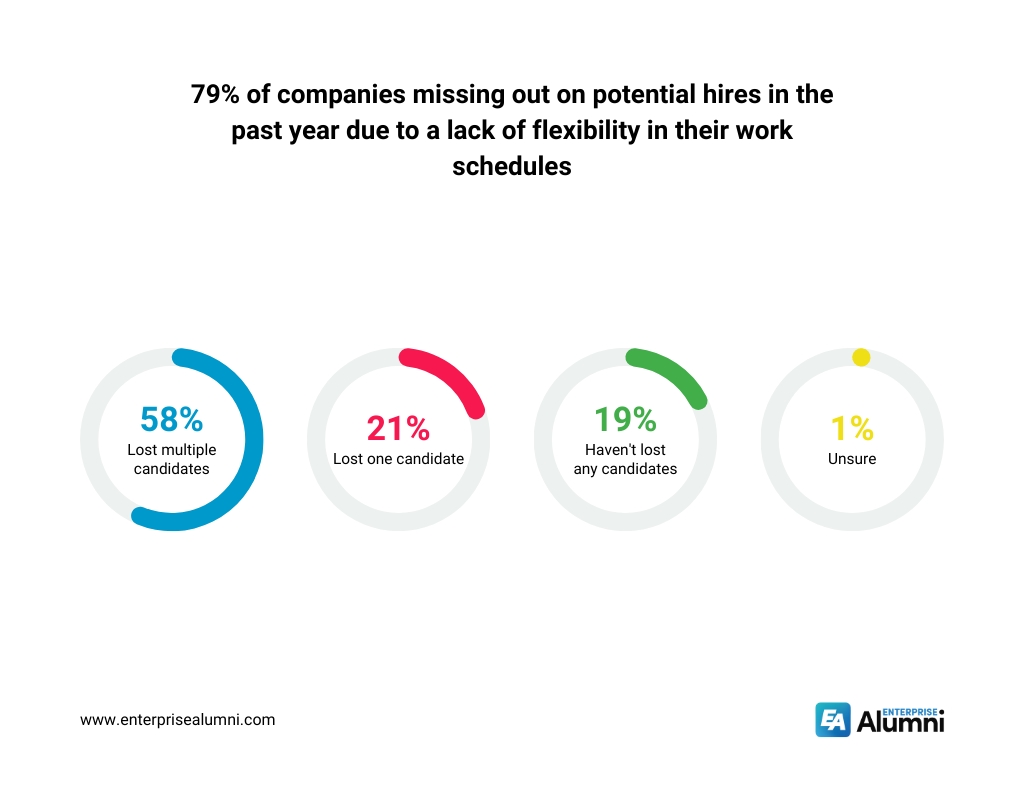
5. 38% of employees feel exhausted after a week of virtual meetings, while 30% feel stressed. [5]
6. According to a global study of over 2,700 employees across 10+ industries by Qualtrics and SAP [6]
- 75% reported feeling more socially isolated
- 67% reported higher stress
- 57% reported greater anxiety
- 53% reported feeling more emotionally exhausted since the outbreak of the pandemic
7. 85% of employees feel the most motivated when management regularly updates company news. [7]
8. Only 42% of employees strongly agree that their leadership effectively leads the organization through the crisis. [8]
9. When employees are extremely satisfied with their company's communication regarding coronavirus, 96% of employees believe their employer prioritizes their safety, but only 30% believe the same when communications are poor. [8]
10. During the pandemic, employees worked up to an extra three hours daily. [9]
11. According to EY's survey of over 5,000 workers from Brazil, China, Germany, the U.K., and the U.S., 82% reported feeling lonely at work, with 49% experiencing increased loneliness since the start of the COVID-19 pandemic. [10]
12. Employees who report poor communication skills with their manager are 23% more likely to experience a decrease in their mental health. [6]
13. 86% of employees report feeling the need to demonstrate their hard work to their bosses to secure their job. [11]
14. 16% of employers are increasingly using technology to monitor employees, such as virtual timekeeping, tracking computer usage, and monitoring email/internal communications. [12]
15. 72% of white-collar workers in the U.S. continue to work from home, while only 14% of blue-collar workers do so. [13]
16. 64% of companies measure employee engagement only once a year. 18% of respondents reported that their companies do not formally assess employee engagement. [14]
17. Only 29% of employees are content with the available opportunities for career advancement. [15]
18. According to FlexJobs, the number of reasons why people leave their job was toxic company culture (62%), followed by poor management (56%) and healthy work-life balance (49%). [16]
Other reasons include the following:
- Lack of remote work options (43%)
- Burnout (42%)
- Inflexible schedules (41%)
- Limited career advancement (37%)
- Inadequate benefits (31%)
- Limited time off or sick leave (27%)
- Insufficient mental health support (22%)
- Job stability concerns (21%)
- Excessive travel (19%)
- Lacking DEI initiatives (19%)
- Disconnection from company mission (18%)
- COVID-19 vaccine requirements worries (17%)
20. 96% of employees consider showing empathy a crucial factor in retaining employees. [18]
21. According to Gallup, only 21% of employees are engaged globally, with the U.S. being the highest (33%) and Europe (14%) lowest. [19]

22. Businesses with engaged employees report 23% higher profits than businesses with disheartened workers. They also experience less absenteeism, employee turnover, theft, safety accidents, customer loyalty, and productivity (sales). [20]
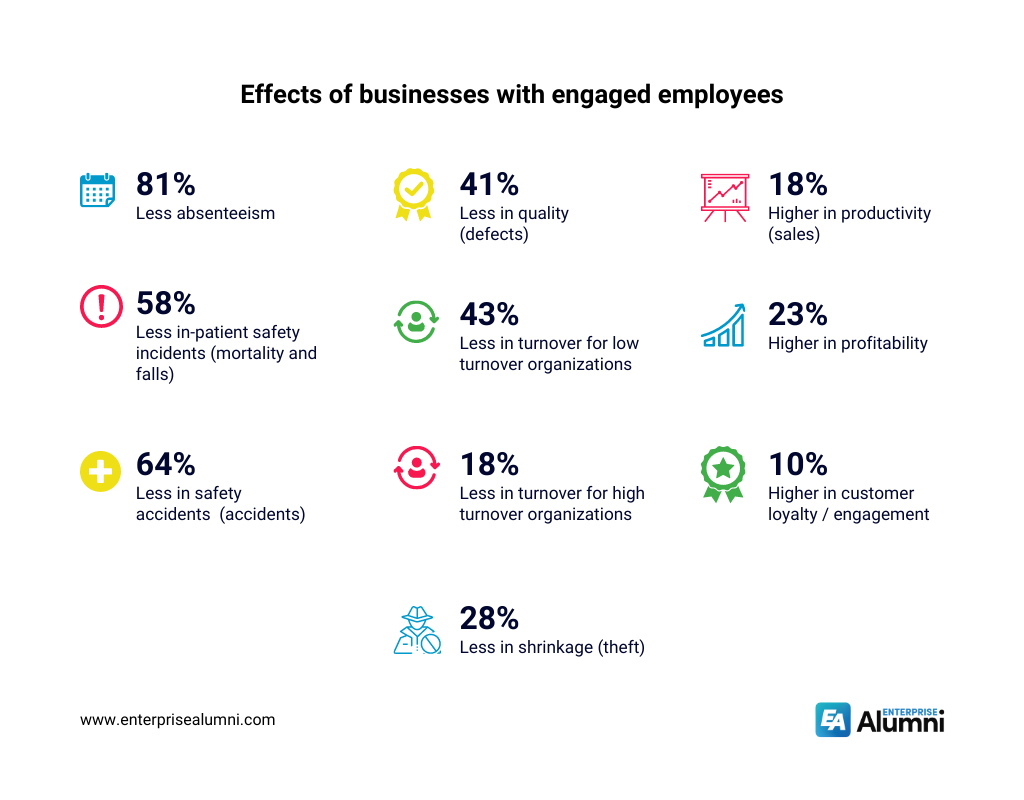
23. Recognized employees are 44% more likely to be "thriving" overall. [21]
24. More than 80% of executives rate employee engagement as important or very important for their company. [14]
25. Employees that aren't recognized are 8x as likely to be actively disengaged and 4x times as likely to look for a new job. [21]
26. Disengaged employees cost the world $7.8 trillion in productivity. That's equal to 11% of the world's GDP. [21]
27. People who feel unseen are 2x as likely to look for a new job in the next 12 months. [22]
28. Employees who strongly believe that recognition is crucial in their workplace are 91% more likely to thrive. (23)
29. When employees are recognized, they are:
- 73% less likely to "always" or "very often" burned out
- 56% less likely to look for new opportunities
- 44% more likely to be thriving
- 5x as likely to feel connected with company culture
- 4x more likely to be engaged
- 5x more likely to see growth in their organization
- 4x more likely to recommend their organization to family and friends [23]

30. Remote employees at companies that celebrate milestones feel more respected (78%) and appreciated (75%) compared to remote employees at companies that don't (58% and 44%, respectively). [22]
31. Employees who lack a sense of belonging are 12 times more likely to lack motivation and 5 times more likely to seek employment elsewhere. [23]
32. Neglecting employee well-being has real and substantial consequences for both workers and their employers:
- A loss of $20 million in potential revenue per 10,000 employees due to poor well-being impacts performance
- A worldwide cost of $322 billion in lost productivity and employee turnover resulting from burnout caused by low well-being. [23]
33. Organizations with high levels of employee engagement saw a 20.1% growth in revenue over 3 years, which is 2.3 times higher than the average growth rate of 8.9%. [14]
34. Only 11% of companies have a highly inclusive work environment. [14]
35. Just one-third of employees feel they are adequately acknowledged for their extra efforts. [24]
36. On average, employees in smaller organizations (11-50 people) receive more recognition than larger organizations. [26]%20receive%20more%20recognition%20than%20larger%20organizations.png?width=1024&height=800&name=36.%20On%20average%2c%20employees%20in%20smaller%20organizations%20(11-50%20people)%20receive%20more%20recognition%20than%20larger%20organizations.png)
37. Money can no longer buy employee loyalty. More than 7 out of 10 employees will stay at the company even if offered a 10% raise elsewhere. [24]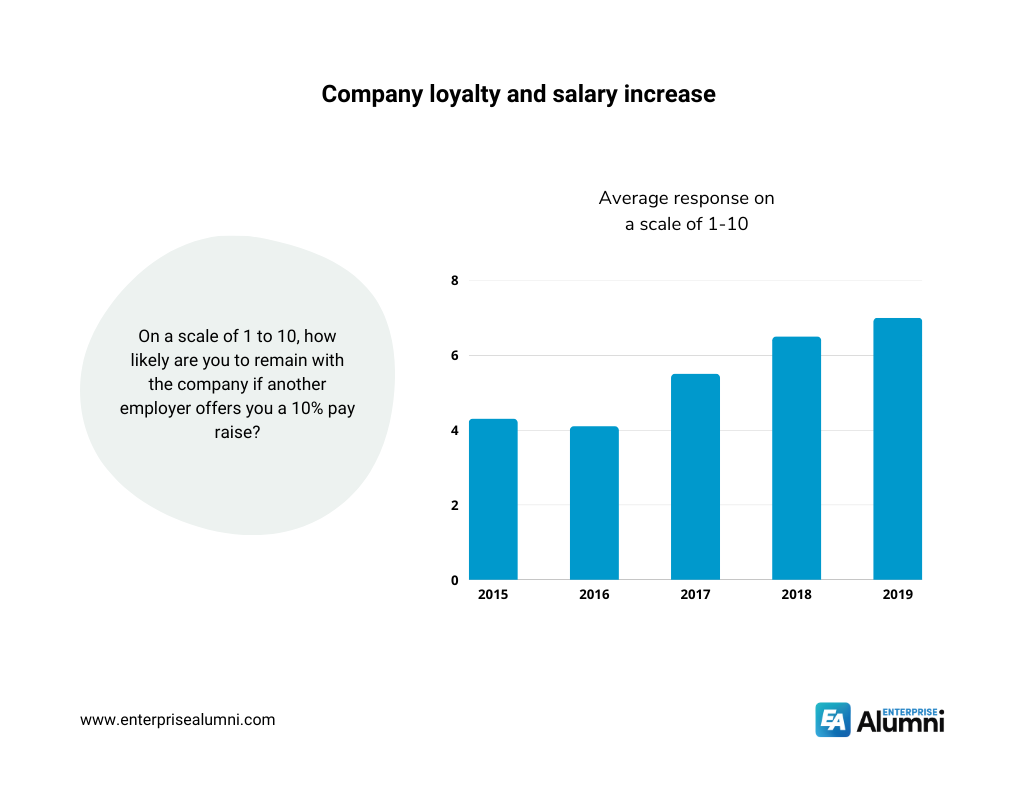
38. Employees show 8x higher engagement and 4x higher intent to stay when leaders make employees feel excited about the future. [25]
39. Top factors in employee engagement are:
- Recognition
- Career development
- Performance management
- Effective infrastructure
- Staffing (hiring and retaining talent)
- Communicating vision
- Caring leadership
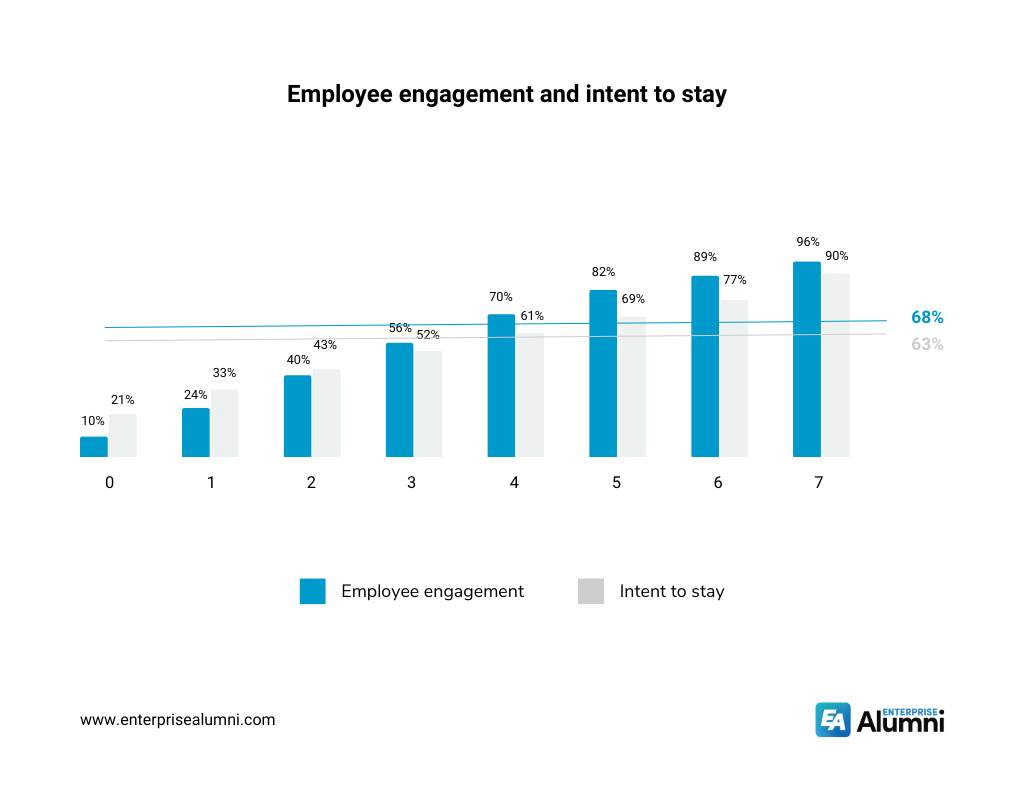
40. Employees are 785% more likely to feel a sense of belonging when they have a strong workplace community. [26]
41. A thriving organizational culture increases the likelihood of a strong workplace community by 12x. [26]
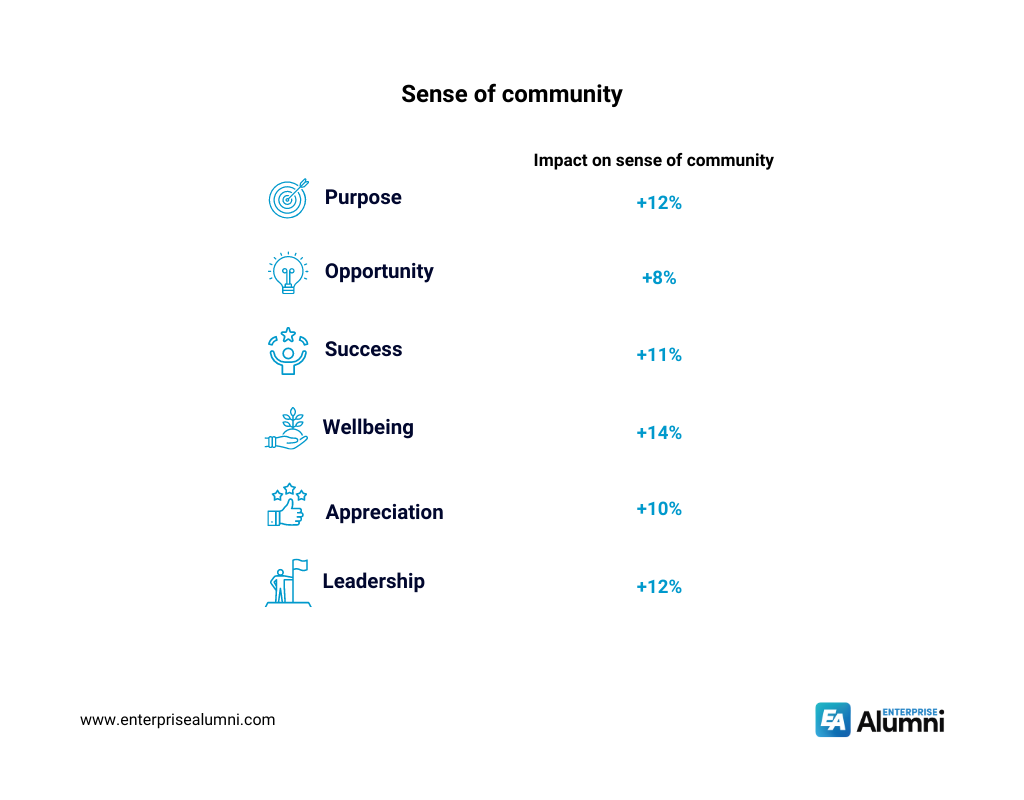
42. There is a 99% chance that employees will feel a sense of belonging in organizations with strong communities & thriving cultures. A strong community and a thriving culture also significantly impact burnout, job retention, inclusiveness, and high-quality work. [26]
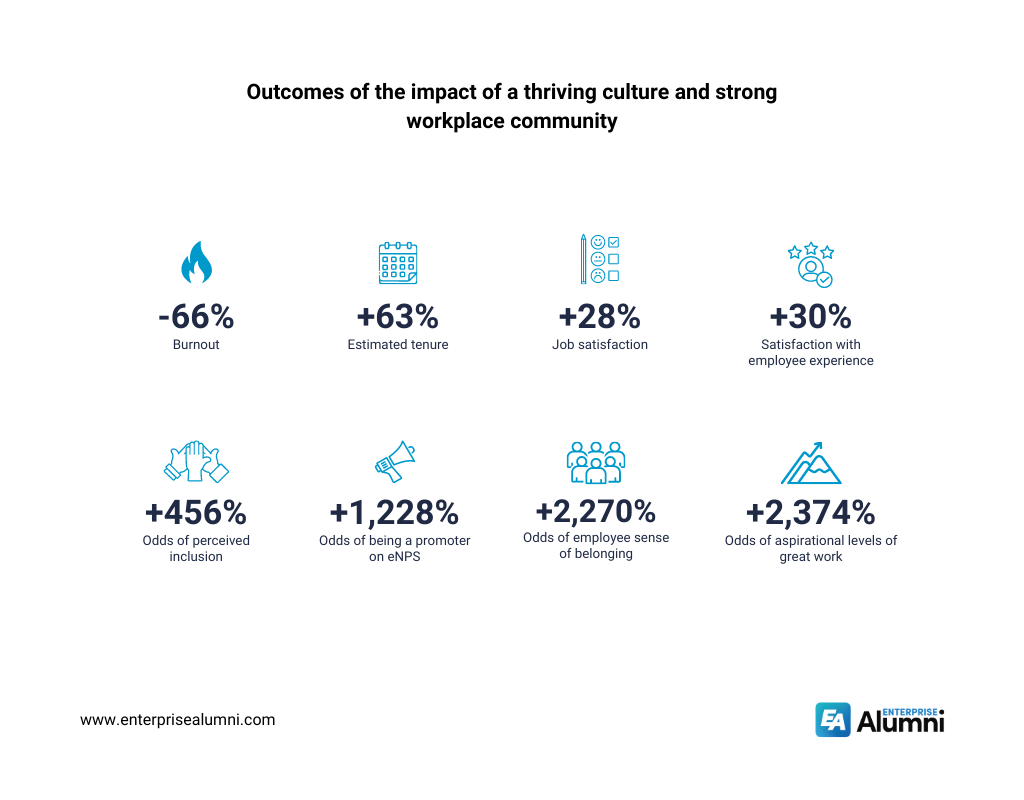
43. Being part of a team that openly discussed stress and anxiety at work was identified as the strongest indicator of employee engagement. [27]
44. Highly engaged employees are 2.3 times more likely to have faith in their company's executive leadership than actively disengaged employees. [27]
45. Employers can save $100B by increasing their employee's sense of belonging. [27]
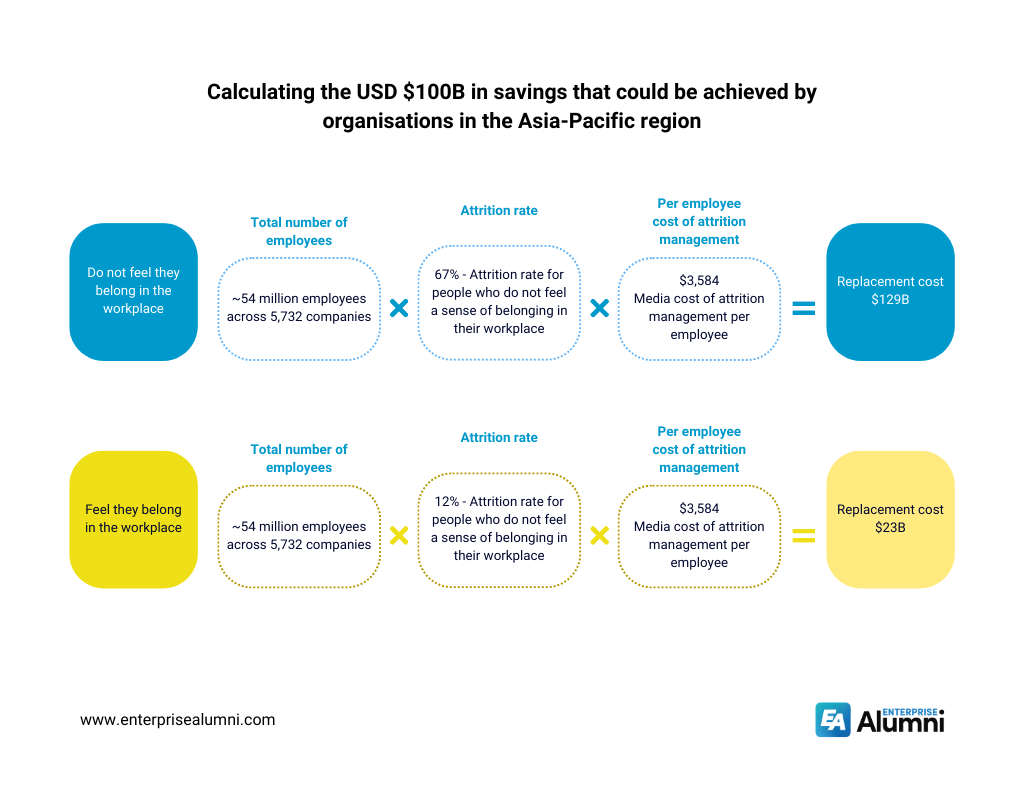
46. Key factors that contribute to a sense of belonging in the workplace: Trust (53%), Respect (48%), Authenticity (45%) [27]

47. Highly engaged employees are 2.8 times more likely to receive recognition for their extra efforts than actively disengaged employees. [27]
48. Burnout cultures have:
- 2.5x less great work
- 41% lower employee experience rating
- 87% less likely to stay
- 3x less engaged
- 22% less output
- 210% decrease in net promoter likelihood
- 23% higher risk of serious illness [26]
Conclusion
Employee engagement plays a crucial role in the success of an organization.
The latest research shows the impact of factors such as a strong workplace community, a thriving culture, open discussions about stress and anxiety, and recognition for extra efforts on employee engagement.
A strong sense of belonging and confidence in leadership also contributes to higher levels of engagement. Organizations can improve productivity, reduce turnover, and increase overall job satisfaction by fostering a positive work environment and encouraging employee engagement.
Resources
-
Gartner HR Survey Reveals 88% of Organizations Have Encouraged or Required Employees to Work From Home Due to Coronavirus (Gartner)
-
Infographic: Enhance the employee experience amid COVID-19 (wtw)
-
Responding To Crisis: Don’t Be Afraid To Take The Hit (Chief Executive)
-
The “Where” of Work Has Been Upended—Next Is the “When” (Capterra)
-
Is Working Remote A Blessing Or Burden? Weighing The Pros And Con (Forbes)
-
How CEOs Can Support Employee Mental Health in a Crisis (Harvard Business Review)
-
Using Internal Communications to Enhance Business Growth (Trade Press Services)
-
COVID-19 Insights Research: What Employees Need From Leaders Now (Perceptyx)
-
Three Hours Longer, the Pandemic Workday Has Obliterated Work-Life Balance (Bloomberg)
-
Employees Around the Globe Feel Lonely, Crave a Sense of Belonging (SHRM)
-
Remote working is causing employees to feel overworked (CityA.M)
-
9 Future of Work Trends For 2023 (Gartner)
-
U.S. Employee Engagement Data Hold Steady in First Half of 2021 (Gallup)
-
Engaging the workforce (Deloitte)
-
SHRM’s 2017 Employee Job Satisfaction and Engagement Report (SHRM)
-
Great Resignation: Survey Finds 1 in 3 Are Considering Quitting Their Jobs (FlexJobs)
-
State Of Remote Work 2019 (Buffer)
-
10 Timely Statistics About The Connection Between Employee Engagement And Wellness (Forbes)
-
State of the Global Workplace: 2022 Report (Gallup)
-
What Is Employee Engagement and How Do You Improve It? (Gallup)
-
Transforming Workplaces Through Recognition (Workhuman)
-
Two Years into COVID: The State of Human Connection at Work (Workhuman)
-
Amplifying Wellbeing at Work and Beyond (Gallup)
-
Employee Engagemnet Report 2020 (TinyPulse)
-
Stability is an illusion —take a closer look. (Kincentric)
-
2023 Global Culture Report (O.C. Tanner Institute)
-
Employee Engagement & Modern Workplace Report (Bonusly)

